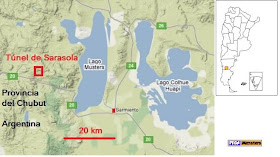My first post done simultaneously in English and Spanish.
Map of Sarasola Cave, Chubut. Copyright © 2010 by Austin Whittall
I stumbled across an excellent blog [1] which mentions a "giant's cave" close to the town of Sarmiento in the Argentine province of Chubut. It intrigued me and I read it expecting to find out about some extant Patagons, but no, it was a cave of something much more interesting:
This Cave or "tunnel" of Sarasola gets its name from the original owner of lot number 103, TomáS Sarasola.
It is a natural cave about 400 m (1,200 ft) long, located on a private property, Estancia Los Manantiales, some 45 km (21 mi.) west of the town of Sarmiento along Provincial Highway No. 20 on the way to Rio Mayo (see the map above).
It was discovered by a native named José Payalef circa 1913, its entrance (see the photographs at the website of Municipal Tourism Office of Sarmiento) is nearly oval and measures 3 m (9 ft.) by 2.5 m ( 8 ft.). It is set in the steppe.
The Giant
The Blog [1] quotes a text which I copy below:
"Old Indians say that some of their fathers knew an enormous giant that was four meters [12 ft.] tall and thick as an ox, which they did not know where it lived, but that they saw many times in the fields close to the cave. Today [ca. 1913] they believe without any doubts, that the giant lived in this cave, which they had not yet discovered by chance because the fields where it lies, lacks grass and water and for this reason not even the cattle went there.” / Sourceuente. Bernardo K. (1)
(1) Encuesta Nacional de Folklore. Ministerio de Educación. (1921). The story comes from the province of Entre Ríos. The surname of the informant is not clearly legible but on the story it figures that during the year of the survey, 1921, he was secretary of the School of Arts and Trades in the town of Victoria.[1]
This survey, was the National Folkloric Survey of 1921 and is filed at the Library Juan Alfonso Carrizo of the Instituto Nacional de Antropología y Pensamiento Latinoamericano (National Institute of Anthropology and Latin American Thought).[2]
It is a collection of handwritten documents which gathered prose, poetry and even music in an attempt to preserve traditional floklore. It was compiled by teachers all over the country. I am programming a visit to the library and museum to read the original text, and will post the outcome of my research.
The description that the local natives made in the early XXth century is not that of a giant person, so we must dismiss the "Patagon". However it seems to me that they are speaking about an extant megafaunal animal, which should have become extinct some ten thousand years ago.
In this blog, I have posed about the possibility that extant megafaunal animals have been the source of several myths (i.e Ellengassen, the glyptodont and the mylodon). In this case, the size of the creature (four meters long and big as an ox) seems to corroborate this hypothesis.
Furthermore it may even be the "lake animal" spotted at the nearby Lake Colhue Huapi.
Sources.
[1] Martelli, Gastón. Geografía Mítica del Territorio Argentino
[2] Biblioteca Juan Alfonso Carrizo
[3] Turismo Municipio de Sarmiento
Lea este post en español
Patagonian Monsters - Cryptozoology, Myths & legends in Patagonia2010 International Year of Biodiversity Copyright 2009-2010 by Austin Whittall ©


No comments:
Post a Comment